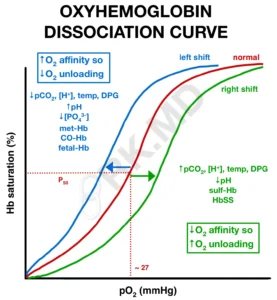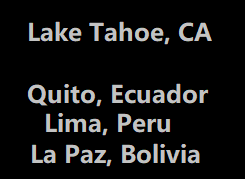
What is 2-3 DPG?
2,3-Diphosphoglycerate (2-3 DPG) is a molecule found in red blood cells that plays a crucial role in regulating the release of oxygen from hemoglobin to tissues, including muscles and organs. In high-altitude mountaineering, where oxygen levels are lower, the body adapts by increasing the production of 2-3 DPG. This adaptation helps hemoglobin release more oxygen to tissues, compensating for the reduced atmospheric oxygen at higher elevations.
The importance of 2-3 DPG in acclimatization is significant because it enhances the body’s ability to cope with hypoxia (low oxygen levels) during climbs. By promoting more efficient oxygen delivery to the tissues, it aids in maintaining energy levels and preventing altitude sickness. This biochemical adjustment is one of the key mechanisms that support mountaineers’ acclimatization and endurance at high altitudes.
Spend some time studying the curve above. It shows how your hemoglobin (the molecule in your blood that transports O2) lets go or holds on to oxygen can shift to the left or right. This is crucial for mountaineering. Any left shift (blue curve) will make you more hypoxic, such as a decreased body temperature or very fast breathing (decreased CO2). Right shifts (green curve) is where you want to be up high. Don’t get cold, and don’t hyperventilate is the message here.
Acclimatization Strategies
- Gradual ascent: Mountaineers should plan for a slow, progressive increase in altitude to allow their bodies time to increase 2,3-DPG production naturally. This approach helps reduce the risk of altitude sickness and improves overall performance.
- “Climb high, sleep low” technique: This strategy involves ascending to higher elevations during the day and returning to lower altitudes for sleep, which can help stimulate 2,3-DPG production and improve oxygen delivery.
Training and Preparation
-
Endurance training: Some research suggests that endurance training can lead to increased 2,3-DPG levels, potentially aiding in altitude adaptation.
-
Pre-acclimatization: Using hypoxic tents or chambers before an expedition can help stimulate physiological adaptations, including changes in 2,3-DPG levels, to prepare the body for high-altitude conditions.
Performance Considerations
-
Intense exercise effects: Mountaineers should be aware that intense exercise in hypoxic conditions can lead to a decrease in 2,3-DPG concentration, primarily due to exercise-induced acidosis. This knowledge can inform pacing strategies during climbs.
-
Hydration and nutrition: Proper hydration and a balanced diet rich in carbohydrates are crucial for maintaining optimal 2,3-DPG levels and supporting acclimatization.
Medical Considerations
-
Acetazolamide use (Diamox): This medication, commonly used to prevent altitude sickness, can affect 2,3-DPG concentrations. Mountaineers using acetazolamide may experience lower 2,3-DPG levels during ascent and at high altitudes. We’re not fans of Diamox…
-
Individual variations: Mountaineers should be aware that 2,3-DPG responses can vary among individuals, and factors such as age, fitness level, and previous altitude exposure may influence adaptation.
By understanding these implications, mountaineers can better prepare for high-altitude expeditions, optimize their acclimatization strategies, and potentially improve their performance and safety in extreme environments.
KORDILLERA Bottom Line
Climb high and sleep low to generate more 2-3 DPG which will regulate better the release of O2 to your tissues. Xenon will not increase your 2-3 DPG levels. Study the curve. A left shift (low or no 2-3 DPG) will not deliver as much oxygen to your brain and other vital organs since your hemoglobin will become stickier and not release it. Diamox will lower your 2-3 DPG. So will a lower temperature – so avoid getting cold on the mountain.



Comments are closed